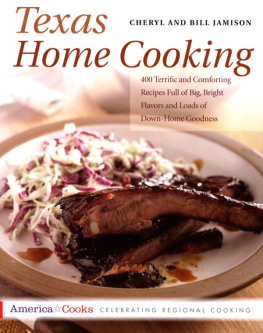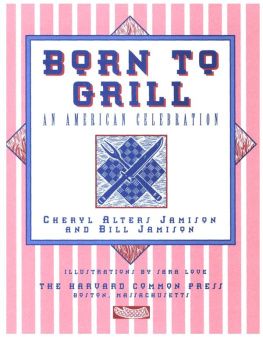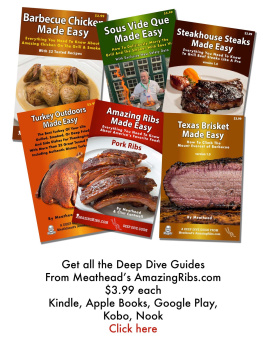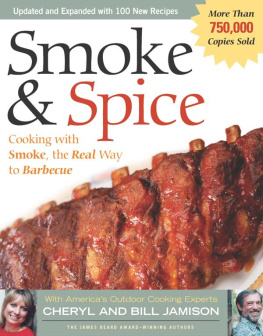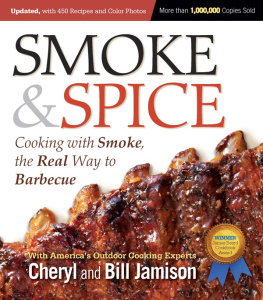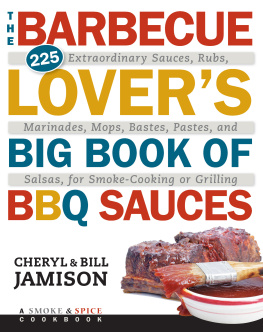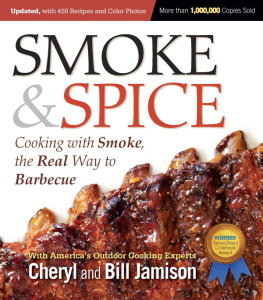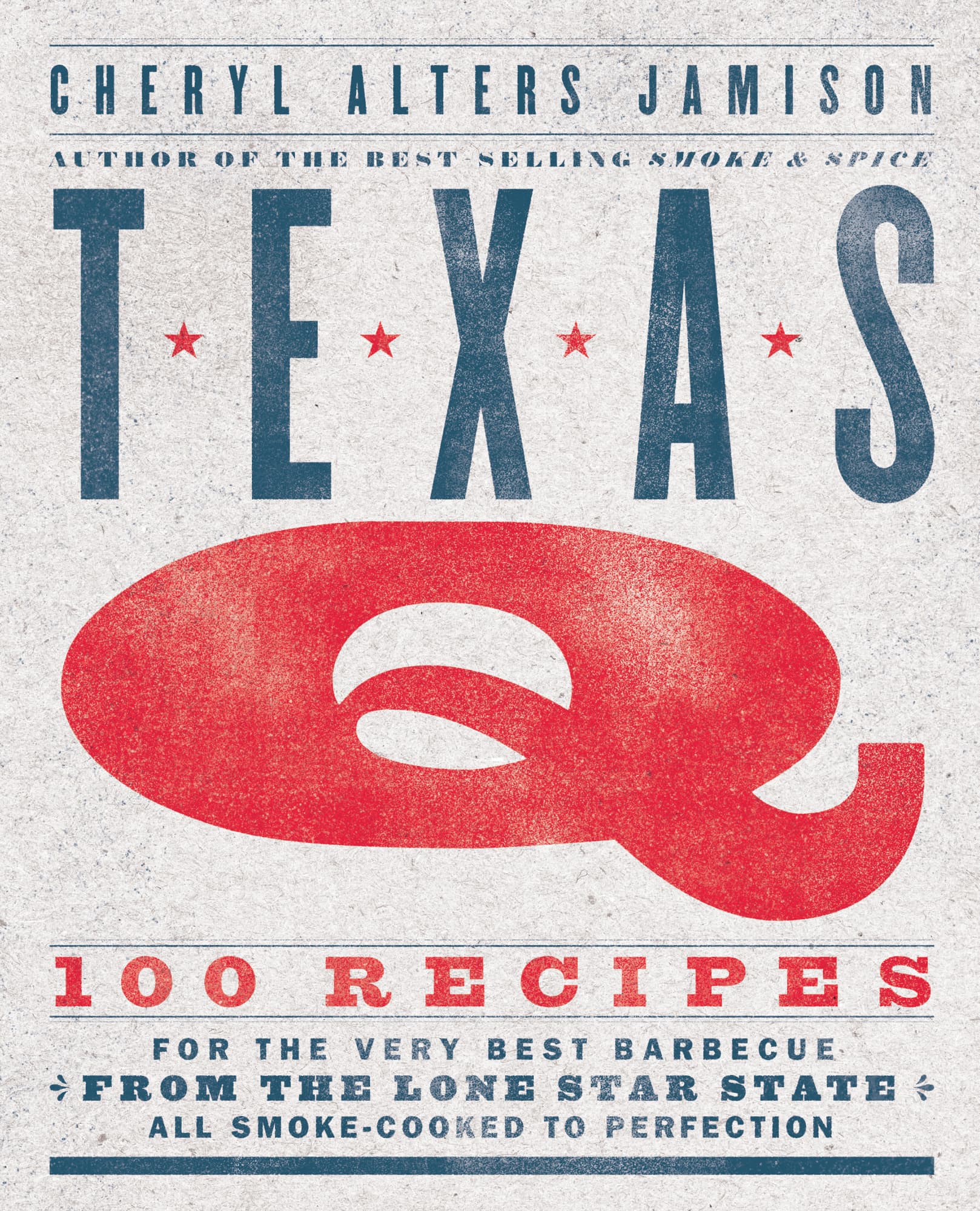PREFACE: My Texas Barbecue Journey
I was not born to Texas barbecue. As a kid growing up in central Illinois, I was familiar with the term used for grilled food and for meat that was tomato saucy and surrounded by a bun, something like a sloppy Joe. I had an early epiphany with true Q on a family trip through Georgia. I got a sandwich that initially horrified mepork instead of beef, with a thin vinegar sauce that maybe had mustard in it too. Astoundingly, coleslaw was plopped on the sandwich, not beside it. I have to admit that I didnt eat much of itjust enough so my parents wouldnt complain that I was wasting food. I just couldnt wrap my head around it. But, I never forgot that sandwich.
A few years later, in the late 1970s, I found myself living in Dallas. A boyfriend of the era was an aficionado of Central Texas barbecue. He loved to regale me with stories about how down in Lockhart, true Q joints served just meat on butcher paper with maybe white bread or onions or dill pickles on the side. If this didnt sound strange enough, he then broke it to me that there was no saucenone. In that heyday of TGI Fridays and fern bars, I couldnt imagine anything that sounded less likely a destination for a food-related field trip.
Nonetheless, the day came for that first visit to Lockhart, to the holy grail of the original Kreutzs, with its raw umber patina of smoke. When I walked in, it smelled promising. A depression in the floor held a wafting wood fire that seemed impossibly far away from where the meat was supposedly cooking. The boyfriend ordered some beef by the pound. Slices came with what I saw as a scorched, crusty surface. I wondered how this meat was so burned when such a wisp of a fire was the source of the heat. By this time, though, the aroma was totally intoxicating. I was coaxed into tasting a bite topped with the craggy surface, or bark, I thought was the burned stuff. The explosion of meaty succulence, of texture, of smoke, was an epiphany. It was as immediately satisfying as that long-ago Georgia sandwich had been disturbing.
So began my immersion and education in Texas barbecue. I think Coopers in Llano came next, where the meat was plucked from big metal boxes outdoors. Each was the size of a chest freezer and had the same kind of prop-up lid. After pointing out the meat we wanted and how much of it, the pit boss on hand would dunk it in a vat of liquid, not quite a sauce by my interpretation. Even though I was somewhat distrustful of sausage, we made a pilgrimage to Luling. City Market cranked out links of something called unpromisingly, to my mind at least, hot guts. Again, I was won over by the coarse meats spicy heat fusing with smoke and the juices dripping down my chin.
Next came Louie Muellers in Taylor. As I exited the screen door, after sampling what I considered to be the most amazing collection of meats I had had anywhere, I thought I was starting to get a sense of this Texas tradition. Yet, I still had a ways to go to grasp the complexity of this elemental form of cooking.
Back in Dallas, I began making the trek to Sonny Bryans stand on Inwood for an early lunch before they ran out of meat. Like everybody else, I either sat at one of the school desks inside or stood against my car door in my heels and business dress to eat chopped beef sandwiches. Here, you could get some tangy rusty-looking sauce, but it didnt taste like the tomatoey liquid called barbecue sauce in grocery stores of the day.
The boyfriend took a job in Louisiana, so I found myself driving many weekends through East Texas, where the barbecue turned out to be very different at places like Bodacious Bar-B-Q in Longview and Country Tavern in Kilgore. I was to learn that the influences came from the Deep South and often from the African-American tradition that was focused more on pork ribs and ladles full of sauce. I found too that what I thought of as Louisiana Cajun flavors didnt stop at the state line.
My many-splendored tour of Texas barbecue took a hiatus when I was offered a career-related move to Santa Fe, New Mexico, in 1980. To feed my barbecue passion, I succumbed to advertising and purchased a small domed vertical cooker, called a water smoker then and often referred to now as a bullet smoker. Trying to get a combination of charcoal and wood chips ignited in it long enough to cook something as small and quick as a chicken breast, much less anything more substantial, was nigh impossible. It seemed as worthless and clunky as a pair of cowboy boots on a ballerina. After a season of futzing around with it, I hauled it to my village dump in total exasperation. Some years later, I decided that little smoker hadnt been a total piece of crap, but the instructions for using it had been.
By that time, I had settled down with another barbecue-loving Texas guy, my late husband, Bill. At the time, we were writing a book that would become Texas Home Cooking. We had been driving around Texas on a late-winter trip, finding inspiration and ideas for the book as a whole. The way we were going to deal with preparing barbecue, the national food of the Lone Star State, was weighing on us. In sampling the attempts of friends, family, and even ourselves, we had become pretty convinced that home cooks should really leave barbecue to seasoned professional pitmasters, sages of smoked meat such as Bobby Mueller of Louie Muellers and Roy Perez of Kreutzs. We were even toying with printing a recipe for Texas barbecue that said hit the highway and make your way to Muellers or Kreutzs, or to other well-regarded joints of the day. At the time, there were no books that explained the process well. Publishers werent roaming the barbecue landscape looking to give pitmasters book contracts. There was no Internet or YouTube with how-to videos. Aaron Franklin, todays reigning barbecue star, was in high school. However, a guy named Wayne Whitworth was about to shake up our whole mindset.
Wed noticed a small recurring ad in Texas Monthly for barbecue pits made in Houston by Pitts & Spitts. Arriving in Houston, I called the company and explained that we were collecting information on proper smoking techniques for a Texas cookbook. I was transferred right to honcho Wayne. I was impressed to be connected right to the top but found out during the conversation that, save the receptionist, Wayne was literally the only one there at the factory/warehouse/
office headquarters. Everyone else was over at the gargantuan Worlds Championship Bar-B-Que Contest, held annually in conjunction with the Houston Livestock Show and Rodeo. Im pretty sure Wayne was a little lonesome sitting there on his own. He said to come right over. We did. We convinced him that we were serious about explaining this barbecue cooking to the greater culinary world if we could figure out how to do it ourselves. He convinced us that, with one of his pits, we could turn tough-as-a-saddle beef brisket into the food of the gods. Furthermore, he announced that he would drive that pit some 880 miles (1416 km) to us and make sure we learned the right way to do Q.

This is how, on an auspicious May Day in 1993, we were set up with a load of oak logs, plenty of food that could soak up smoke, and beerlots of beer. The hardwood logs needed to fuel the incoming Pitts & Spitts barbecue pit had been a lot harder to come by than the beer. Most people in Santa Fe, New Mexico, at 7,000 feet (2 km) in the southern Rocky Mountains, burn pion, a soft but strongly aromatic pine that grows in the area. It burns hot and fast with a lot of pitch, exactly the opposite of what is required for barbecue. I called restaurants around town that claimed to offer smoked or wood-grilled dishes on their menus. We got leads on mesquite, but it burned hotter than we wanted for our first attempts at serious Central Texasstyle barbecue. The chef at a then-well-known rib chain told me that there was no need to find real wood. All I had to do was drown the meat in liquid smoke and bake it. Finally, I found a purveyor of pion who also scavenged oak. We were ready for what was about to become our first weeklong barbecue.


